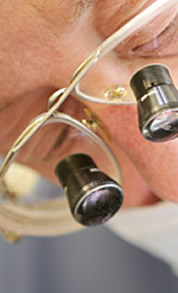Teeth Filling
If a single spot on one of your teeth is not cleaned daily, the remaining bacteria will transform themselves into a sticky film substance called plaque. The plaque will produce acids which eat away at the enamel of the tooth and will eventually cause cavities.When the cavity gets through the enamel, into the underlying tooth structure (the dentin), repair or restoration is necessary.
Composite Resin
Made of
A mixture of plastic and fine glass particles.
Used for
Small and large fillings, especially in front teeth or the visible parts of teeth, inlay
Advantages and Disadvantages of Composite Resin
Advantages
Your fillings or inlay will be invisible. Your dentist chooses a resin that matches the color of your teeth.
A filling can be completed during one dental visit. An inlay may require two visits.
Composite fillings can bond directly to the tooth, making the tooth stronger than it would be with an amalgam filling.
Less drilling is involved than with amalgam fillings because your dentist does not have to shape the space as much to hold the filling securely. The bonding process holds the composite resin in the tooth.
Indirect composite fillings and inlays are heat-cured, increasing their strength.
Composite resin can be combined with glass ionomer to provide the benefits of both materials.
Disadvantages
Although composite resins have become stronger and more resistant to wear, it’s not clear whether they are strong enough to last as long as amalgam fillings under the pressure of chewing.
These fillings take 10 to 20 minutes longer, or sometimes more, to place than amalgam fillings because each thin layer of the filling must be cured, or hardened, using a visible blue light.
Indirect fillings and inlays take at least two visits to complete. Your dentist takes impressions at the first visit and places the filling or inlay at the second visit.
In large cavities, composites may not last as long as amalgam fillings.




